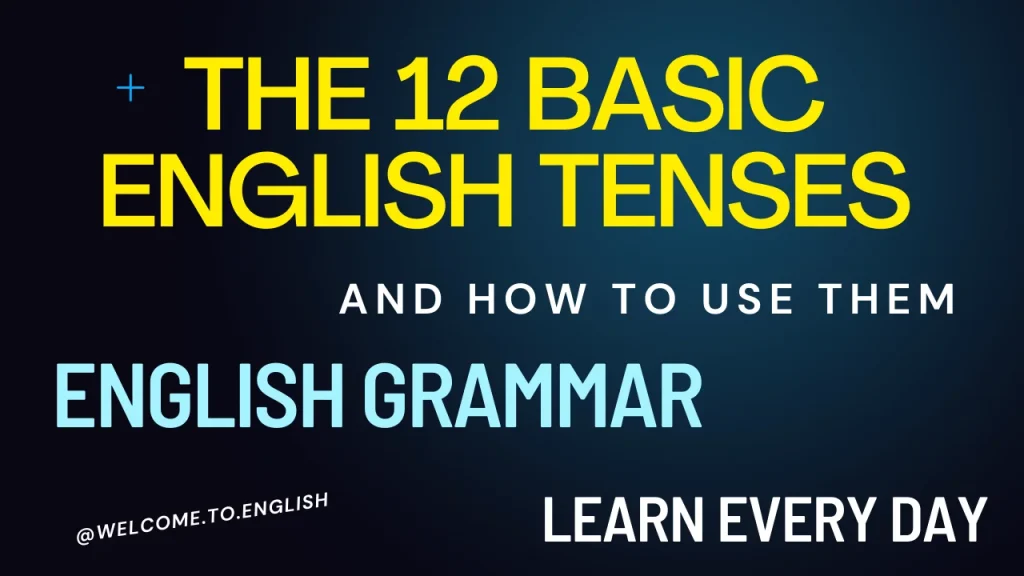
English has 12 verb tenses, which are categorized into three main groups: past, present, and future. Each tense serves a specific purpose and helps convey when an action or state of being occurs. Here’s an explanation of each tense along with examples:
1. Simple Present Tense:
- Structure: Subject + Base Verb (e.g., I walk, he speaks)
- Usage: Describes actions that are habitual, factual, or general truths.
- She sings beautifully.
- They work in the city.
2. Present Continuous Tense:
- Structure: Subject + Present Participle (am/is/are) + Base Verb + -ing (e.g., I am walking, he is speaking)
- Usage: Describes actions happening at the moment or around the present time.
- I am studying for my exams.
- He is watching TV.
3. Present Perfect Tense:
- Structure: Subject + Present Perfect (have/has) + Past Participle (e.g., I have walked, she has spoken)
- Usage: Describes actions completed recently or at an unspecified time before now.
- They have visited Paris.
- She has finished her book.
4. Present Perfect Continuous Tense:
- Structure: Subject + Present Perfect (have/has) + Been + Present Participle (e.g., I have been walking, he has been speaking)
- Usage: Describes continuous actions that started in the past and continue into the present.
- I have been working all day.
- She has been studying for hours.
5. Simple Past Tense:
- Structure: Subject + Past Verb (e.g., I walked, he spoke)
- Usage: Describes completed actions in the past.
- We visited the museum.
- He played soccer yesterday.
6. Past Continuous Tense:
- Structure: Subject + Past Tense (was/were) + Present Participle (e.g., I was walking, they were speaking)
- Usage: Describes ongoing actions or events in the past.
- I was reading when he called.
- They were studying all night.
7. Past Perfect Tense:
- Structure: Subject + Past Perfect (had) + Past Participle (e.g., I had walked, she had spoken)
- Usage: Describes an action completed before another action in the past.
- He had already left when I arrived.
- She had finished the project before the deadline.
8. Past Perfect Continuous Tense:
- Structure: Subject + Past Perfect (had) + Been + Present Participle (e.g., I had been walking, he had been speaking)
- Usage: Describes continuous actions that were ongoing and completed before another action in the past.
- I had been working for hours before he called.
- She had been practicing for the concert.
9. Simple Future Tense:
- Structure: Subject + Will + Base Verb (e.g., I will walk, he will speak)
- Usage: Describes actions that will happen in the future.
- We will meet tomorrow.
- She will finish the project next week.
10. Future Continuous Tense:
- Structure: Subject + Will + Be + Present Participle (e.g., I will be walking, he will be speaking)
- Usage: Describes ongoing actions that will happen in the future.
- I will be studying when you arrive.
- They will be traveling next month.
11. Future Perfect Tense:
- Structure: Subject + Will + Have + Past Participle (e.g., I will have walked, she will have spoken)
- Usage: Describes actions that will be completed before another action in the future.
- By next year, they will have graduated.
- He will have finished his book by the end of the month.
12. Future Perfect Continuous Tense:
- Structure: Subject + Will + Have + Been + Present Participle (e.g., I will have been walking, he will have been speaking)
- Usage: Describes continuous actions that will be ongoing and completed before another action in the future.
- By the time you arrive, I will have been waiting for an hour.
- She will have been working here for five years by next summer.
Understanding and mastering “ALL 12 Verb Tenses” is crucial for effective communication in English. Practice using them in different contexts to improve your language skills.